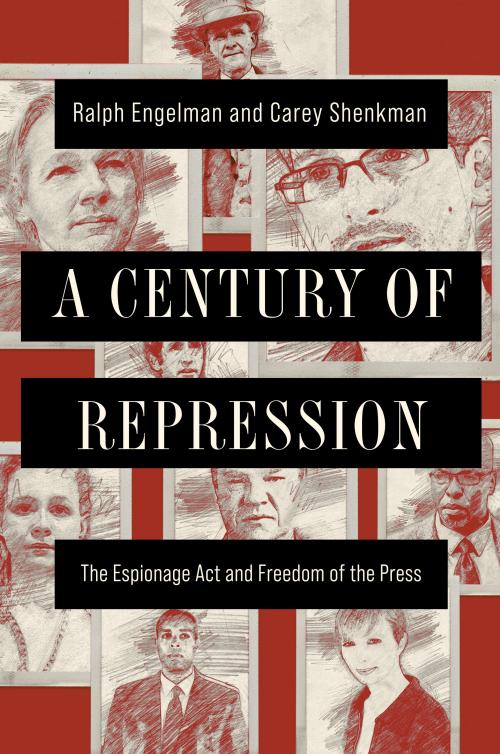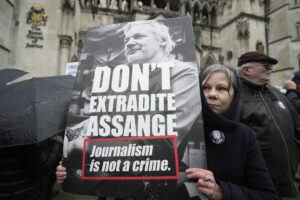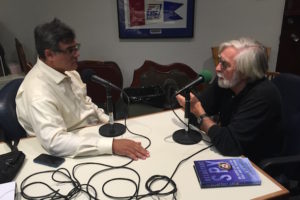A Century of Repression: The Espionage Act and Freedom of the Press
How the Espionage Act of 1917 is the most important yet least understood law threatening freedom of the press in modern American history. Spies. Photo: Kieran Lamb / CC BY-SA 2.0
Spies. Photo: Kieran Lamb / CC BY-SA 2.0
The following is adapted from A Century of Repression The Espionage Act and Freedom of the Press, by Ralph Engelman and Carey Shenkman, published in October by University of Illinois Press.
The Espionage Act of 1917 is the most important yet least understood piece of legislation threatening the free flow of information in American history. To date no single volume systematically traces the century-long life of the law—spanning the two World Wars, the Cold War and the War on Terror—and reveals the scope of its threat to freedom of expression. Its very name is a misnomer, since its scope extends well beyond spying. Indeed, this volume does not examine use of the Act against espionage as commonly understood: spying for a foreign government. Rather it reveals the law’s multi-faceted and increasingly widespread use to limit free speech, a free press and freedom of information in regard to US foreign and military policy. Yet the name of the law taints prosecutions of political dissidents and whistleblowers with an aura of disloyalty and national betrayal. The Espionage Act provides a lens through which to view a century of American political history. An examination of its trajectory provides new perspectives on American liberalism, the FBI and the civil liberties movement.
Since the First World War, successive administrations deployed the Espionage Act for varied political purposes, both domestic and foreign. Some prosecutions resulted in sensational trials; others were little noticed or understood. Indeed, the Act has existed under the public radar for significant lengths of time. It lives in the shadows of virtually every military conflict and foreign policy controversy in the past century. Consider this volume the biography of a law with far-reaching implications for freedom of expression in times of war. It entails the stories of targets of Espionage Act prosecutions—of Eugene Debs, Samuel Morison, Daniel Ellsberg, Chelsea Manning, Thomas Drake, Julian Assange, Edward Snowden, and Reality Winner, among others. The playbook of Espionage Act prosecutions is laden with the settling of political scores, character assassination, illegal break-ins, and prosecutorial misconduct. Targets include government critics and internal whistleblowers—as well as the journalists who covered them. Many Espionage Act prosecutions collapsed; others resulted in draconian sentences. Yet all defendants paid a high price for their ordeals in their personal and professional lives.
“If there should be disloyalty, it will be dealt with with a firm hand of stern repression,” Woodrow Wilson declared on April 2, 1917, in his address to a joint session of Congress calling for a declaration of war.[i] Wilson issued that warning to German Americans and, by extension, to others opposed US entry into the European conflict. The Espionage Act of 1917 would become the principal tool for repression of opposition to the US war effort—and a powerful weapon of the federal government against freedom of expression for dissidents and whistleblowers in the century that followed. To be sure, as its name suggested, the Espionage Act established harsh penalties for spying for a foreign enemy in wartime. However, the Wilson administration deployed the Act to control information and public opinion in light of widespread opposition to US participation in the war. The amendment known as the Sedition Act of 1918 strengthened the Espionage Act as a blunt instrument for repression of political dissent, particularly of the leaders and publications of the socialist, syndicalist and Black movements of the period. It proscribed “disloyal, profane, scurrilous or abusive language” about the American war effort and system of government.[ii] It established a system to censor publications, administered by the US Post Office. Thus, at the urging of the Wilson administration, Congress enacted the first federal sedition legislation since the expiration and widespread repudiation of the Alien and Sedition Acts of 1798. The Espionage Act would remain a vehicle for government suppression of information and criticism regarding US foreign and military policies for the century that followed.
Since the First World War, successive administrations deployed the Espionage Act for varied political purposes, both domestic and foreign. Some prosecutions resulted in sensational trials; others were little noticed or understood. Indeed, the Act has existed under the public radar for significant lengths of time. It lives in the shadows of virtually every military conflict and foreign policy controversy in the past century.
From the outset, the law was applied to targets both small and large. Take, for example, the case of the hapless Robert Goldstein, producer of a film entitled The Spirit of ’76.[iii] Goldstein was the owner of an apparels shop that supplied costumes to early Hollywood movies, including D.W. Griffith’s The Birth of a Nation. Aspiring to do for the American Revolution what Griffith had done for the Civil War and Reconstruction Era, Goldstein sunk $200,000 into a silent epic film with massive sets and a cast of hundreds about the War of Independence. It included signature moments like the signing of the Declaration of Independence, a subplot about efforts to install King George’s mistress as “Queen of America,” and graphic images of British atrocities. The film opened in May 1917, just weeks after US entry into the war. Goldstein was charged under the newly minted Espionage Act with attempting to harm the war effort by portraying the US’s chief ally in a critical light, and sentenced to ten years’ imprisonment. Hollywood was being enlisted in the war effort, and even negative images of an ally set in the distant past would not be countenanced. Goldstein was released, penniless, after three years. He sought to restart his film career, first in the US and then in succession of European countries. Both Goldstein and his film eventually disappeared from sight. Goldstein was last heard from in 1935, writing from Germany, where he could not afford to pay nine dollars to renew his passport. He is presumed to have perished in a concentration camp. No copy of The Spirit of ’76 seems to have survived him.
If the trial of Robert Goldstein seems arbitrary, the prosecution of William “Big Bill” Haywood was not. For the business community and government officials, the radical labor leader was one of the most hated and feared figures in the nation. Haywood, a former miner and brawling revolutionary labor leader from the West, was broad-shouldered, with one dead eye and a scarred face, usually topped by a black Stetson cowboy hat.[iv] The organization he led, the Industrial Workers of the World (the IWW, or Wobblies), was as threatening to authorities as its leader’s persona. Established in 1905, the IWW was the most radical mass labor organization in American history. At its 1916 convention, the organization added an anti-war plank to its program of revolutionary syndicalism. “With the European war for conquest and exploitation raging and destroying our lives,” its resolution stated, “…we openly declare ourselves the determined opponents of all nationalistic sectionalism, or patriotism, and the militarism preached and supported by our one enemy, the capitalist class.”[v] Based in the western US, the Wobblies were a powerful force in sectors of the American economy like mining, lumber and shipping essential to the war effort.
No wonder, then, that Haywood was tried, in Chicago in 1918, as the lead defendant together with one hundred other IWW leaders for violation of the Espionage Act before Judge Kenesaw Mountain Landis (the future Commissioner of Baseball). All were found guilty, and Haywood received a 20-year sentence. Released on bail, he saw the US Circuit Court reject the IWW appeals. Haywood was in poor health, determined not to return to jail once again, this time possibly for the rest of his days. On March 31, 1921, disguised with a monocle over his bad eye and carrying a false passport, he boarded the S.S. Oscar II, bound for the Soviet Union via Stockholm. After working on an American-run experimental industrial colony in Western Siberia, making a speaking tour in Russia and writing his autobiography, Haywood spent his last years languishing in Moscow at the Hotel Lux, a hotel for visiting foreign leftists and residence for exiled communists. His loneliness was tempered by alcohol and occasional visits from old comrades from home; he died in 1928.
The stories of Robert Goldstein and Big Bill Haywood—their differences notwithstanding— illustrate the personal cost of being the target of an Espionage Act prosecution, a recurring pattern down to our own day. They also suggest the remarkable personalities and high drama often at play in Espionage Act cases, bringing to mind Philip Roth’s adage that American reality can trump the fiction writer’s imagination. This is true of the odyssey of Daniel Ellsberg and the ordeal of Chelsea Manning. Observe the mild-mannered Edward Snowden, holed up for months in Moscow’s Sheremetyevo Airport, after charges were unsealed against him in June 2013 for violating the Espionage Act by giving the press classified documents from the NSA. Witness Julian Assange, dragged by British police from the cramped Ecuadorian Embassy in London in April 2019 to face extradition to the US on Espionage Act. Lesser-known proceedings would also have significant ramifications, such as the Amerasia case following WW II, which proved central to the rise of Senator Joseph McCarthy. The spate of Espionage Act prosecutions during the Obama and Trump administrations spawned a new array of targets, among them beleaguered confidential sources working for the FBI (Donald Sachtleben, Terry Albury), the CIA (Jeffrey Sterling, John Kiriakou), the NSA (Reality Winner, Thomas Drake) and the State Department (Stephen Kim).
Our cast of characters also features a succession of remarkable defense attorneys who fought Espionage Act cases. Take, for example, Gilbert E. Roe, the law partner and studious counterpart to Senator Robert M. “Fighting Bob” La Follette of Wisconsin, who fought the prosecutions of the Masses and socialist leader Eugene Debs. Roe was a leader of the Free Speech League, which had previously defended the First Amendment rights of members of the IWW and Emma Goldman, among others. Fast-forward a half century to the trial of Daniel Ellsberg, represented by the disheveled-looking but astute civil rights attorney Leonard Boudin. Boudin had taken the lead in defending victims of the McCarthy era; his list of clients ranged from civil rights leader Paul Robeson and accused spy Judith Coplon to social activists Dr. Spock and Julian Bond. In contrast, Abbe Lowell, a more buttoned-up and establishment-connected Washington, D.C., defense attorney, defended representatives of the American Israel Public Affairs Committee (AIPAC), and later State Department contractor Stephen Kim, against Espionage Act charges. And the human rights attorney Jesselyn Radack, a whistleblower herself, has represented NSA whistleblowers Thomas Drake and Edward Snowden, and National Geospatial Intelligence Agency analyst Daniel Hale. A former employee of the Justice Department, Radack was forced to resign and faced criminal investigation after she exposed the FBI’s illegal interrogation in a major terrorism case. The professional histories of these attorneys, as well as the arguments they articulated in defense of their clients, underscore the political nature of Espionage Act cases over the past century.
From the outset, the story of the Espionage Act features a succession of larger-than-life figures. One of them is Oliver Wendell Holmes Jr., the legendary Supreme Court Justice, who embodied the contradictory views of WW I-era Progressives about freedom of expression in wartime. Holmes—scion of a prominent Massachusetts family, Harvard-educated, a Civil War veteran, 77-years-of-age in 1919, with his imposing white handlebar mustache, ramrod posture and formidable ego—was the ultimate embodiment of the Boston Brahmin. In 1919, he wrote majority opinions upholding three convictions under the Espionage Act for, respectively, an anti-draft flyer, a series of newspaper editorials, and a speech by Eugene Debs. But a group of young acolytes of the aging and childless Supreme Court sage mounted a campaign to get Holmes to reconsider a position that in their view threatened First Amendment freedoms. Three key figures in this cabal would subsequently have illustrious careers: Harold Laski as a leader of the British Labor Party, Felix Frankfurter as a Supreme Court Justice, and Zechariah Chafee as the preeminent First Amendment scholar of the 20thcentury. The result of their efforts was Holmes’s famous dissent in Abrams v. United States (1919), considered a foundation for freedom of expression in modern America.
Wilson’s Justice Department, which zealously pursued Espionage Act prosecutions with the aid of the vigilante American Protective League, was led by two prominent trustbusters: Attorney General Thomas W. Gregory and John Lord O’Brian, head of the Justice Department’s War Emergency Division.
Holmes was not alone in his inconsistency in regard to the issues posed by the Espionage Act, the product of the best and brightest minds of the Progressive legal establishment of the early 20th century. Wilson’s Justice Department, which zealously pursued Espionage Act prosecutions with the aid of the vigilante American Protective League, was led by two prominent trustbusters: Attorney General Thomas W. Gregory and John Lord O’Brian, head of the Justice Department’s War Emergency Division. O’Brian, the chief enforcer of the Act, later squared a circle, gaining a reputation as a civil libertarian in the long and distinguished career that followed his tenure during WW I. Future liberal attorneys general would be personally torn by the dilemmas posed by prosecutions under the Act. Francis Biddle, Justice Holmes’s former law clerk who served as Franklin D. Roosevelt’s attorney general, was ambivalent about FDR’s desire during the Second World War to use the Act to prosecute Colonel Robert McCormick’s Chicago Tribune and to threaten the dissident Black press. And upon stepping down as Barack Obama’s attorney general, Eric Holder would say his greatest regret was implicating a reporter in an Espionage Act case. Holder would go on to call for reform of the Espionage Act and limitation of its potential application to the media. Hence the drama surrounding the Act takes place in the internal private struggles of key officials as well as on the public courtroom stage.
Two important figures emerge from the shadows of the Espionage Act and the Justice Department’s efforts to stem dissent. In 1917, John Lord O’Brian hired 22-year-old J. Edgar Hoover to work in the War Emergency Division as a favor for a politically connected uncle of Hoover’s. The young Hoover was the product of the conservative Capitol Hill neighborhood of lower-level civil servants in Washington, D.C. He had attended night school at George Washington University Law School, financing his education by working as a clerk at the Library of Congress. Hoover became head of the Justice Department’s Alien Enemy Bureau, which administered the requirement that “enemy aliens”—that is, unnaturalized German and Austro-Hungarians living in the US—register with the government. The Bureau had the added authority under the Espionage Act of investigating subversive aliens, who could be imprisoned without trial, placed in two camps operated by the War Department, or face deportment. Hoover became a major player in the Palmer Raids of 1919-1920 in which alien political radicals were expelled from the US. The colorless but ambitious Hoover, astute at bureaucratic maneuvering and empire building, had begun his ascent. He would play an important role in Espionage Act prosecutions through the 1970s. More generally, the campaign against dissent during WW I, with the Espionage Act as its centerpiece, had a profound impact on Hoover’s worldview. The culture of Wilson’s wartime Justice Department, the association of dissent with treason, provided the template for the record of repressive actions and violations of civil liberties during Hoover’s subsequent tenure as director of the FBI.
The Espionage Act also jumpstarted the trajectory of another major 20th-century figure in the struggle over civil liberties in the 20th century. The law propelled the career of Hoover’s civil libertarian counterpart, Roger N. Baldwin, founder and longtime head of the American Civil Liberties Union.
Footnotes
[i] Woodrow Wilson, Address delivered at Joint Session of the Two Houses of Congress, April 2, 1919, 65th Cong., 1stSess., Senate Doc. No. 5, Serial No. 7264, Washington, D.C., 1917.
[ii] Sedition Act of 1918, Pub. L. 65-150, 40 Stat. 553 (1918).
[iii] See Anthony Slide, ed. Robert Goldstein and ‘The Spirit of ’76 (New York: Scarecrow Press, 1993); and Michael Selig, “United States v. Motion Picture Film The Spirit of’76: The Espionage Case of Producer Robert Goldstein (1917),” Journal of Popular Film and Television, 10, no. 3 (April 2013): 168-174, https://doi.org/10.1080/01956051.1983.10661939.
[iv] Peter Carlson, Roughneck: The Life and Times of Big Bill Haywood (New York: W.W. Norton, 1983), 9, 16.
[v] Industrial Workers of the World, “The IWW Position on War,” https://www.iww.org/de/history/resolutions/Convention_war_1916.
Your support matters…Independent journalism is under threat and overshadowed by heavily funded mainstream media.
You can help level the playing field. Become a member.
Your tax-deductible contribution keeps us digging beneath the headlines to give you thought-provoking, investigative reporting and analysis that unearths what's really happening- without compromise.
Give today to support our courageous, independent journalists.







You need to be a supporter to comment.
There are currently no responses to this article.
Be the first to respond.